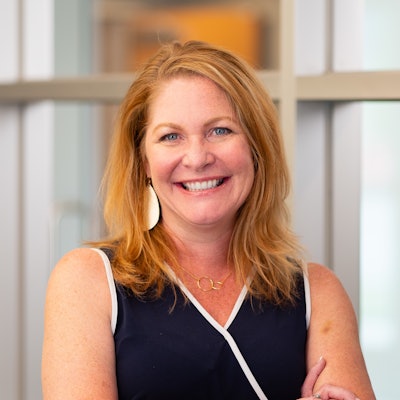The number of academic credits a student takes per year has ties to their likelihood to graduate and complete their college journey, a new report from course scheduling company Ad Astra found. Sarah Collins
Sarah Collins
Ad Astra’s 2024 Benchmark Report – released on Feb. 20 – dives into data from its partner institutions to look at potential relationships between access to courses, credits taken per school year, and college completion. It analyzed data about 1.3 million students, coming from two- and four-year public or private institutions.
One of the characteristics that sets this report apart is how it separates students not only by part-time versus full-time, but also by splitting within those two categories themselves in terms of annual credits taken, what the report authors refer to as ‘degree velocity.’
Part-time students are separated between those taking 1-11 (‘walking’), 12-17 (‘speed-walking’), or 18-23 annual credits (‘jogging’). Similarly, full-time enrollees are split between those taking 24-29 credits a year (‘running’) and those taking 30 or more (‘sprinting’).
A student’s likelihood to complete their academic pursuit – and to even keep enrolled – was found to correlate to the number of credits they took a year, according to the report. For instance, ‘walking’ students had a 29% retention rate and a 7% rate of completion. But student who were even just one tier up, ‘speed-walking,’ saw retention rates jump to 53% and likelihood of completing to 26%.
Most students who are ‘walking’ (71%) don’t even continue past their first year in college, according to the report.
Recognizing this effect presents Ad Astra’s partner colleges and universities a feasible goal for their students, Ad Astra President Sarah Collins said. Instead of trying to get part-time students to move to full-time, they can try to get students to increase their annual credits by a smaller amount and still see improvements in outcomes.
But what affects a student’s decision or ability to go up a tier and quicken their academic pace may not be up to them. Research from Ad Astra found that there is an “extremely strong correlation” between a student’s credit hours and the availability of those courses in a schedule, Collins said.
“We identified that it isn't even just that the course may not be available but [that] it might not be available in the way in which the student is progressing through their degree,” Collins said.
The report’s authors use the term ‘completion path’ to refer to this way that a student chooses to progress towards their degree – a combination of modality (online or on-campus), location, and time of day that the class takes place during.
So this course availability problem can happen as a result of the course a student needs not lining up with their chosen completion path, whether it’s because the required course is only offered on a different campus, only offered during a certain time of the day that doesn’t work for the student, or because the term length of the course overlaps with another’s – a “blocked completion path.”
“A lot of our first-gen students – or just modern-day students today – they have complicated lives. They are working. They're caring for either elders or children. There's many things going on in their lives,” Collins said. “And when we can't continue to offer classes in the way they're taking them, ... we found that those kinds of things decrease the number of credit hours they took. And as students had a lower and lower credit hour load, their likelihood of completing got significantly less.”
Schools expand how, when, and where they offer courses to provide more flexibility to students – and increase enrollment as a result – but doing so without planning and coordinating to avoid blocked completion paths can be an issue, Collins said. Instead of providing flexibility, they could be creating obstructions instead.
“Once they start to stack all those different various offering types on top of each other, they're actually creating more conflicts for the student because there isn't intentional design,” she said.
More than half of the students analyzed by Ad Astra (57%) were found to be in blocked completion paths, which means they will have to make a major change in their path to finish their degree, according to the report.
Offering a myriad of options that end up conflicting with each other imposes costs on both the student and the institution, Collins said. Keeping that many options alive is financially unsustainable for schools, and hurdles on students’ completion paths means they have to spend more time and money in school.
“Our study found 78% of the Completion Paths have unsustainable enrollment levels, many of which are being financially subsidized,” the report noted. “It is better to fully support fewer Completion Paths than offering a few courses in various, random ways.”
Included in the report are multiple calls to action, suggestions on ways in which higher ed institutions avoid pitfalls such as unsustainability and blocked paths. Collins also suggested that schools engage in “integrated planning” by coordinating course schedules within academic departments and providing multi-year schedules so students can plan for the long-term better.
“Taking a cross-departmental, data-informed, and holistic approach to course scheduling is crucial,” Dr. Laura Boyer, vice president for academic success at Northeast Lakeview College, said in an email. Data on Northeast Lakeview is included in the report.
“Siloes in the schedule build often lead to unintended barriers to student progression. A collaborative data-informed approach facilitates identifying and eliminating schedule conflicts across disciplines and building innovative and coherent schedule pathways for students to complete degrees.”







![Mentor Mentee [60287]](https://img.diverseeducation.com/files/base/diverse/all/image/2024/04/Mentor_mentee__60287_.662959db8fddb.png?auto=format%2Ccompress&fit=crop&h=167&q=70&w=250)













